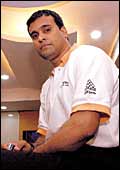 |
"Employees who are
weeded out need not necessarily be incompetent; they could be
in the wrong role"
Bhaskar Das, Vice President
(HR) Cognizant Technology Solutions |
Between
October 2003 and March this year, Satyam Computer Services had 900
of its employees packing their bags to find jobs elsewhere. No,
there was no crisis at the Hyderabad-based company and neither had
any rival mass-poached these code jocks. Rather, it was Satyam's
performance management system at work. Innocuously named Value Creation
Cycle, the hr tool works more like a scythe, weeding out a big chunk
of the worst performers every year. The 900 departees amounted to,
then, 5 per cent of Satyam's headcount. "Call it involuntary
attrition," quips T. Hari, Vice President of hr at Satyam.
First introduced by Jack Welch at General Electric
as Vitality Curve (in a moment, we'll explain why it is called so
at GE), the controversial hr tool is finding eager adopters in India,
including some big names like Wipro Technologies, ICICI Bank and
Cognizant Technology Solutions. While its nature and implementation
may vary from company to company, and it may go under different
names (Value Creation Cycle, Capability Maturity Rating Scale, Performance
Watch, Performance Differentiation Curve, TopGrading, and Forced
Ranking are just some) the system's underlying philosophy is the
same: Cull out the poor performers.
How does it work? Typically, managers slot
their reportees in categories of A, B and C, with the first category
representing the top 20 per cent of the performers and 70 per cent
falling under the second category. The worst performers get slotted
in C. Think of employee performance as a bell curve (GE's Vitality
Curve is in reference to this statistical tool), where a small proportion
of employees come at the top, a large number make up the middle
and the underperformers fall on the line. At most practitioners
of forced ranking, the underperformers are given a year to improve.
If they don't move up even after that, they are simply shipped out.
"Growth happens only when there are differential rewards for
differential performers," says Ram Kumar, General Manager of
hr at ICICI Bank.
| THE PROS AND CONS |
WHY IT WORKS
» Creates
an environment of excellence and competition
» Creates
a leadership pipeline and greater management depth
» By churning
people, brings in fresh ideas and newer skills
» Rewards
people in proportion to their performance on the job
WHY IT DOESN'T
» Needs
a corporate culture that's prepared for forced ranking
» Makes
employees compete and not cooperate with each other
» Doesn't
identify the reasons for non-performance or failure
» Needs
a transparent and constant system of feedback
|
At ICICI Bank, this macro-economic philosophy
manifests itself in a six-point rating scale, where not more than
5 per cent of the employees are allowed to be categorised as excellent
and a whopping 15 per cent are herded into the "unacceptable"
category (this is a slightly different version of forced ranking
and is often referred to as forced distribution). Similarly, Wipro
Technologies employs a "capability maturity rating scale"
as part of its assessment system. Employees are rated on parameters
of performance, potential, criticality, market skills and competencies,
and categorised as A, B or C. At Satyam, employees are slotted as
one of the following: smart, meritorious, adequate, reasonable or
trail (smart).
No employee at any of these companies is without
his or her key result areas (KRAs), and business goals are planned
for each employee at the beginning of the performance appraisal
cycle. Performance is tracked annually, although half-yearly reviews
are held to take stock. Quantifiable goals and qualitative issues
are factored in by the line manager before the rating is assigned.
"No rating comes as a surprise, since expectations are all
discussed in advance," says Pratik Kumar, VP of HR at Wipro
Technologies.
 |
"New employees help a
company's intellectual and innovative capacity keep pace with
its physical growth"
T. Hari, Vice President
(HR) Satyam Computer Services |
A Cruel System?
Behind this controversial system lies the need
to create an organisation of super-performers. By necessarily forcing
out a minimum number of employees, usually between 5 and 10 per
cent of workforce, the system ensures that only the best are recognised,
rewarded and retained. It also helps weed out those who do not have
it in them to make it to the next level. Says ICICI Bank's Kumar:
"Employees often outgrow their level of competency and the
effort needed to get them in the acceptance level is Herculean."
Bringing in new employees every year, says Satyam's Hari, helps
infuse fresh ideas so that the company's intellectual and innovative
capacity keeps pace with physical growth.
Underperformers usually get a year to shape
up. They are put on a performance improvement plan (pip), which
is monitored by heads of business units. Those who improve along
the growth curve are inducted back into the system, and those who
don't are given the pink slip. But as Bhaskar Das, VP (HR), Cognizant,
points out, employees weeded out are not necessarily incompetent.
It could well be a case of the person having been given a wrong
role, wrong performance goals, or simply needed different skills
to succeed in the job. "Sometimes the employees who are let
go grow at a different trajectory in another place," notes
ICICI Bank's Kumar.
 |
"Growth happens only
when there are differential rewards for differential performances"
Ram Kumar, General Manager
(HR) ICICI Bank |
Understandably, then, not everybody is a fan
of forced ranking. Its critics see a number of things that can go
wrong with it. For one, they say, if some people are not performing
to expectation, it possibly indicates the company hired the wrong
person to start with. Therefore, shipping them out in two years'
time is good neither for the company (in terms of time and money
invested in hiring) nor the employee. Then, "it can result
in an (internally) competitive rather than a collaborative environment",
warns Sonal Agrawal, Director, Accord India, an executive search
firm. In fact, it is quite conceivable that employees may want to
work with one (powerful) manager over another. Also, as Hari Iyer,
Head of hr at Sasken Communication Technologies (it ranked No. 1
in BT's Best Companies to Work For survey recently) points out:
"People have enormous resilience to come back, and a theory
like this is quite against the human spirit." At Sasken, for
instance, the rating system is designed to develop and reorient
the underperformers and not discard them.
In the us, practioners of forced ranking like
Ford Motor have been hit with court cases by employees for alleged
discrimination. Critics of forced ranking say that such a situation
develops when line managers are not transparent enough with their
employees in terms of appraisal. For instance, a manager who tells
an employee that everything is fine with him or her, but suddenly
assigns a poor rating at the end of the year, will necessarily be
hard-pressed to explain the assessment.
Notwithstanding the concerns, more and more
companies want to tighten their performance appraisal system. Come
March 2005, HDFC (another of BT's Best Companies to Work For) will
replace its subjective rating system with a 10-scale performance
score that will bring transparency to appraisals and improve performance.
"We've been very soft on people all along, but that will not
do in this competitive scenario," says Manju Malkani, Deputy
gm of hr. White-collar workers of the country, take note.
|
